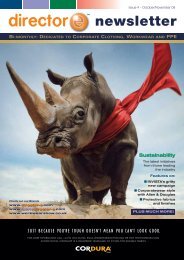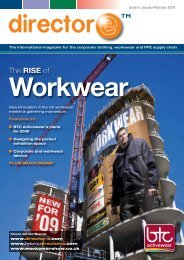Official Show Guide - director-e
Official Show Guide - director-e
Official Show Guide - director-e
You also want an ePaper? Increase the reach of your titles
YUMPU automatically turns print PDFs into web optimized ePapers that Google loves.
This time last year, when I made my<br />
presentation at the Workwear and<br />
Corporate Clothing Conference, I listed<br />
some concerns that I believed would<br />
impact sourcing in 2008/9. These<br />
concerns included a shortage of labour in Eastern<br />
European countries such as Romania, and resulting<br />
higher prices, increased concern on the part of<br />
consumers for ethical and environmental issues,<br />
wage inflation in China, and the possibility of antidumping<br />
legislation being invoked.<br />
Events in the past six months in the world’s financial<br />
markets have to a large extent overshadowed these<br />
concerns. There are many rumours flying around<br />
about factories being forced to close, about<br />
workers not having jobs to come back to after<br />
Chinese New Year, and about the effect that the<br />
decline in the value of sterling is having on our<br />
buying power. The global apparel market is suffering<br />
in the same way as many other markets, but it is<br />
important to get our facts straight - not least<br />
because, if we don’t, we risk missing out on some<br />
opportunities that are opening up. So to what<br />
extent are the issues that I flagged up a year ago<br />
still important?<br />
Largely due to the economic downturn in the UK<br />
and the Eurozone, the shortage of labour in Eastern<br />
Europe appears to be less acute now than it was<br />
then, as Eastern European nationals are returning<br />
home. Chinese wage inflation is not the issue that it<br />
appeared to be at that time. The environment<br />
continues to be a major concern, but the new<br />
American administration seems to be taking a very<br />
different attitude and working with China on this,<br />
and there have been no instances of anti-dumping<br />
rules having to be invoked in the clothing sector - in<br />
fact, the World Trade Organisation is on record as<br />
saying that across all categories of trade, there have<br />
been fewer cases of dumping in the past six<br />
months than at any time in the past.<br />
So, let’s look in greater detail at what occurred in<br />
the second half of 2008, and the impact that this<br />
may have on business in 2009.<br />
Who’s up, who’s down<br />
As I write, the most up-to-date information we have<br />
for imports into the EU is for the third quarter of<br />
2008, before the effects of the global economic<br />
downturn really started to bite. But, in spite of this,<br />
what these figures show us is that, compared with<br />
the same quarter in 2007,<br />
there have been some<br />
significant shifts in the<br />
marketplace, with<br />
countries such as<br />
Bangladesh, India and<br />
Pakistan showing a<br />
decline in sales and, at the<br />
same time, sales from<br />
Vietnam, Indonesia and<br />
Cambodia improving quite<br />
significantly . China, the<br />
world’s largest exporter,<br />
remained stable.<br />
Among those countries<br />
that border the EU, we<br />
see a similar picture, with<br />
some countries up and<br />
others down. Most<br />
significantly, Turkey lost<br />
sales, as did Romania,<br />
Morocco and Tunisia,<br />
some of the more traditional neighbour sources,<br />
while the emerging markets of the Balkans such as<br />
Serbia, Albania and Macedonia saw their exports<br />
grow, as did Egypt.<br />
What appears to be happening is that buyers in<br />
search of lower prices are becoming more confident<br />
operating in countries that, until a couple of years<br />
ago, would have been considered risky. Now that<br />
some of the more adventurous have established<br />
factories in these countries, the opportunity for<br />
others is opening up in much the same way as it did<br />
in Romania and Bulgaria in the early to mid 1990s.<br />
What might the future hold?<br />
For many buyers in the corporate, workwear and<br />
PPE sectors, the ability to react quickly to change is<br />
top of the list of priorities, especially in the current<br />
economic climate. Being able to turn production on<br />
and off is far easier when you do not have to<br />
contend with long lead times, so sourcing<br />
production closer to home becomes more<br />
desirable. In the past couple of years, however, the<br />
cost of production in nearby countries, in particular<br />
those that have recently joined the EU, has<br />
rocketed. For example, Romania, for many years<br />
one of the most important sources of tailored<br />
garments, blouses and outerwear, has suffered<br />
from labour shortages, due to widespread migration<br />
of workers into the EU. During 2008, Romanian<br />
factories struggled to find enough trained labour to<br />
Winners and<br />
Losers in the<br />
New Global<br />
Order<br />
Liz Leffman, <strong>director</strong> of Clothesource, looks at the way sourcing has changed in the<br />
past 12 months, and what the future may bring.<br />
There have been some<br />
significant shifts in the<br />
market place, with<br />
countries such as<br />
Bangladesh, India and<br />
Pakistan showing a<br />
decline in sales and, at<br />
the same time, sales<br />
from Vietnam,<br />
Indonesia and<br />
Cambodia improving<br />
quite significantly<br />
fill their vacancies, with the<br />
consequent problem of<br />
severe wage inflation. But,<br />
as jobs in Western Europe<br />
have dried up thanks to<br />
the credit crunch and<br />
workers have started to<br />
drift back home,<br />
Romanian factories have<br />
started to find it easier to<br />
recruit. And, as retail<br />
buyers cut back their<br />
orders, opportunities are<br />
emerging, with factories<br />
actively seeking new<br />
customers for the first<br />
time in many years.<br />
Add to this the fact that<br />
the Romanian currency<br />
inflated less against<br />
sterling than the<br />
currencies of all other major producing countries,<br />
and suddenly Romania looks more attractive. For<br />
buyers, it will be a case of balancing speed of<br />
response against price but, as demand shrinks,<br />
many factories will be open to negotiation, and it is<br />
likely that we will see a slow-down in price inflation<br />
right across the Euromed region.<br />
Looking further afield, China will remain the most<br />
important supplier, but canny buyers will make sure<br />
that they spread risk by moving some of their<br />
production elsewhere. The most likely countries to<br />
benefit will be Vietnam and Cambodia, both of<br />
which are attractive for being politically stable and<br />
having a wide range of well equipped factories.<br />
Bangladesh will continue to offer the lowest prices,<br />
but here price will need to be balanced against the<br />
possibility of disruption as the country has had a<br />
series of strikes recently.<br />
Staying informed has never been more<br />
important. “The Source” is Clothesource’s<br />
monthly newsletter, full of information about<br />
the global market for apparel, costing £150 for<br />
a year’s subscription. We are offering <strong>director</strong>e<br />
readers two monthly editions FREE.<br />
To sign up, please send an email to<br />
intelligence@clothesource.net with ‘<strong>director</strong>-e<br />
offer’ as the subject. You will receive the latest<br />
edition by return.<br />
54<br />
54 www.<strong>director</strong>-e.com www.fabric<strong>director</strong>-e.com www.workwearshow.co.uk




